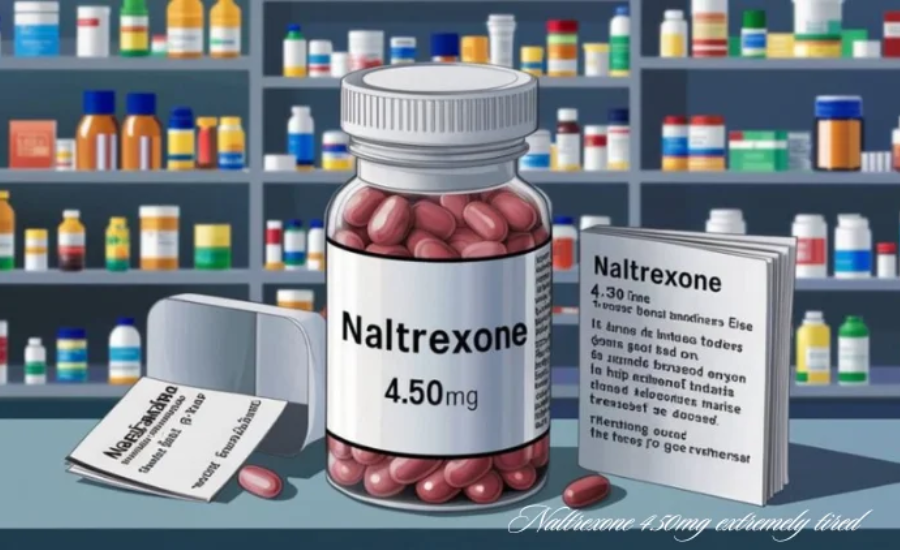Naltrexone 4.50mg is commonly prescribed to assist individuals with alcohol and opioid dependence by blocking the pleasurable effects of these substances, aiding in the recovery process. While effective, Naltrexone comes with a range of side effects that users should be mindful of. Recognizing and addressing these potential side effects is important for anyone taking or considering this medication.
Why Naltrexone 4.50mg is Used

Naltrexone 4.50mg is a medication commonly prescribed to individuals struggling with alcohol and opioid dependence, playing a crucial role in supporting recovery by reducing the pleasurable effects of these substances and helping to prevent relapse. It works by blocking opioid receptors in the brain, which are responsible for the euphoric feelings induced by alcohol and opioids, making it easier for individuals to maintain sobriety by reducing cravings. Naltrexone is often used in conjunction with other forms of treatment, such as therapy, counseling, and support groups, to address both the physical and psychological aspects of addiction. It is particularly helpful in preventing relapse, providing ongoing support during long-term recovery by stabilizing cravings and promoting healthier coping mechanisms. For those in recovery, Naltrexone serves as a vital tool, assisting them in staying substance-free and reinforcing their commitment to sobriety as part of a comprehensive treatment plan.
Typical Side Effects of Naltrexone 4.50mg
When initiating treatment with Naltrexone 4.50mg, some individuals may experience common, mild side effects. These effects generally subside as the body becomes accustomed to the medication.
Nausea
Nausea is one of the most commonly experienced side effects during the early stages of Naltrexone treatment. This sensation may occur as the body adjusts to the medication, often within the first few days or weeks of starting the drug. For some individuals, this can cause discomfort and may impact their ability to continue with daily activities. To alleviate nausea, it is recommended to take Naltrexone with meals or a light snack, as food can help buffer the stomach and reduce the feeling of queasiness. Additionally, if nausea persists or becomes severe, consulting a healthcare provider is advised to rule out any other underlying causes and explore alternative solutions.
Headaches
Headaches are another frequent side effect that some individuals experience when beginning Naltrexone treatment. Dehydration and insufficient rest can exacerbate this symptom. To manage headaches, it’s important to stay hydrated by drinking plenty of water throughout the day. Also, ensuring adequate sleep and rest may help mitigate the frequency and severity of headaches. If the headaches persist or become intolerable, discussing the issue with a healthcare professional is crucial, as they may recommend pain relief strategies or adjust the treatment.
Dizziness
Some users may report feeling dizzy or lightheaded during the initial period of taking Naltrexone. This dizziness can manifest as a sensation of unsteadiness or spinning and may make it difficult for individuals to perform everyday activities. The feeling of dizziness can be particularly disorienting when it occurs suddenly or without warning. During this time, it is important to avoid activities that require full concentration and coordination, such as driving or operating heavy machinery, until the dizziness subsides. If dizziness is persistent or severe, seeking medical advice is recommended to ensure that the cause is related to Naltrexone and not another underlying health issue.
Fatigue
Fatigue is a common side effect during the early stages of Naltrexone use. Individuals may feel unusually tired or experience a lack of energy, even after a full night’s sleep. This can affect daily functioning and may make it difficult to focus on tasks or engage in physical activities. Fatigue is generally temporary and tends to improve as the body adjusts to the medication. However, if fatigue becomes overwhelming or continues for an extended period, it is important to make sure that other lifestyle factors, such as nutrition and sleep hygiene, are optimized. Eating a balanced diet, staying physically active, and ensuring sufficient rest are essential steps in combating fatigue. Consulting a healthcare provider may also help if the fatigue becomes persistent or interferes with quality of life.
Sleep Disturbances

Difficulty sleeping, including trouble falling asleep or staying asleep, is another potential side effect of Naltrexone. These sleep disturbances can lead to feelings of frustration and further exacerbate fatigue. Some individuals may find that they are unable to relax or fall asleep easily, while others might experience frequent waking throughout the night. To improve sleep quality, it is recommended to establish a consistent bedtime routine, such as going to bed and waking up at the same time each day. Avoiding stimulants such as caffeine, nicotine, or heavy meals in the evening can also help promote better sleep. Creating a calm and relaxing sleep environment, free from distractions such as electronics, may further aid in falling asleep and achieving restful sleep. If sleep disturbances continue to be an issue, it is important to consult with a healthcare provider to explore potential solutions, including adjusting the dosage or considering alternative medications.
Less Frequent Side Effects
In addition to the common effects, some individuals may experience less frequent side effects. Although rare, these side effects may require attention from a healthcare provider.
Abdominal Discomfort: Stomach pain or cramps can occur.If these symptoms continue or become more severe, it’s important to seek advice from a healthcare professional.
Muscle and Joint Discomfort: Some individuals report aches in muscles or joints. Light exercise and stretching might help alleviate these symptoms.
Increased Anxiety: Though not a typical side effect, some users may experience heightened anxiety. If anxiety becomes severe or overwhelming, it is important to seek medical advice.
Loss of Appetite: Some individuals may notice a reduction in appetite, which could lead to weight loss. It is vital to maintain proper nutrition and consult with a dietitian if necessary.
Skin Reactions: Rashes or itching may indicate an allergic reaction. In such cases, it’s important to stop the medication and seek immediate medical assistance.
Rare and Serious Side Effects
In rare instances, Naltrexone 4.50mg may cause severe side effects that require urgent medical attention.
Liver Damage
Liver complications can occur as a result of Naltrexone 4.50mg use, particularly with long-term treatment. Symptoms of liver damage include jaundice, which is the yellowing of the skin or eyes, dark-colored urine, light-colored stools, and persistent or severe abdominal pain. These signs should be taken seriously, as they may indicate liver dysfunction or damage. For individuals on extended Naltrexone therapy, regular liver function tests are recommended to monitor for any potential issues. These tests help healthcare providers identify problems early, ensuring that appropriate action can be taken to prevent further damage. If any of these symptoms develop, it’s vital to seek medical attention promptly to protect liver health and adjust the treatment if necessary.
Severe Mood Changes

Naltrexone can occasionally cause significant mood disturbances, including symptoms of depression. These mood changes may manifest as intense feelings of sadness, hopelessness, irritability, or a loss of interest in activities that once brought joy. In some cases, these depressive episodes can become severe and require immediate attention. If mood changes are noticed, especially if they affect daily functioning or lead to thoughts of self-harm or suicide, it is essential to contact a healthcare provider right away. Prompt intervention can help manage these symptoms and prevent further mental health challenges. It’s also important to remember that depression may not be directly caused by Naltrexone, and other underlying factors may need to be explored by a professional.
Severe Allergic Reactions
Though rare, some individuals may experience severe allergic reactions to Naltrexone. These reactions can be serious and may include symptoms such as swelling of the face, lips, tongue, or throat, which can lead to difficulty breathing or swallowing. A severe skin rash, hives, or itching may also occur. These symptoms can be life-threatening if not addressed promptly, requiring immediate medical attention. If any of these signs appear after starting Naltrexone, it’s crucial to stop taking the medication and seek emergency medical help right away. Healthcare providers may recommend an alternative treatment or closely monitor the individual for any further allergic responses to prevent complications.
necessary in these cases.
Tips for Managing Side Effects of Naltrexone 4.50mg
Managing Naltrexone’s side effects involves several practical steps to ensure the medication is as effective and comfortable as possible.
Consult Regularly with Your Healthcare Provider
Maintaining an open and ongoing dialogue with your healthcare provider is crucial when taking Naltrexone 4.50mg, especially over an extended period. Regular consultations allow for the monitoring of any side effects or changes in your health status, ensuring that adjustments can be made to your treatment plan as necessary. By discussing any concerns, whether they relate to new symptoms or the effectiveness of the medication, you empower your healthcare team to tailor your treatment to your specific needs. This proactive approach not only helps manage side effects but also ensures that your recovery remains on track, addressing any issues before they become more significant health concerns.
Follow Dosage Guidelines
Adhering to the prescribed dosage of Naltrexone is essential for maximizing its effectiveness while minimizing the risk of side effects. It’s important to take the medication exactly as directed by your healthcare provider, as any deviation from the recommended dosage could affect its ability to manage cravings and support recovery. Additionally, it’s crucial to avoid alcohol and opioid use during treatment, as combining these substances with Naltrexone can lead to severe adverse reactions. Sticking to the prescribed regimen and refraining from these substances helps maintain the integrity of your treatment and ensures that you get the full benefit of the medication without introducing dangerous interactions.
Adopt Healthy Lifestyle Practices
Supporting your recovery and managing potential side effects of Naltrexone 4.50mg can be significantly enhanced by adopting healthy lifestyle practices. Eating a balanced and nutritious diet helps your body better process the medication, while staying hydrated ensures that your body functions optimally. Regular physical activity not only promotes overall well-being but also helps combat common side effects like fatigue and mood fluctuations. Additionally, ensuring sufficient rest each night is vital for both physical and mental recovery, allowing your body to heal and recharge. By maintaining these habits, you create a strong foundation for your recovery and increase your ability to manage any side effects that may arise during treatment.
Long-Term Use Considerations

For individuals using Naltrexone 4.50mg over an extended period, it’s essential to be aware of the potential long-term side effects and the importance of regular check-ups and health assessments. These routine visits enable healthcare providers to monitor for any developing issues, ensuring early detection and timely intervention. Since the effects of long-term medication use can vary, maintaining an open and transparent dialogue with healthcare providers is crucial. Reporting any new, persistent, or worsening symptoms promptly allows for adjustments to the treatment plan or further investigations into possible side effects. By proactively addressing any concerns, individuals can minimize the risk of serious complications, leading to a smoother recovery process and a better overall outcome in the long run.
FAQs About Naltrexone 4.50mg Side Effect
Q: What is Naltrexone 4.50mg used for?
A: Naltrexone 4.50mg is primarily prescribed to help individuals with alcohol and opioid dependence by blocking the pleasurable effects of these substances.The medication is used as part of a comprehensive treatment plan, which may include therapy and support groups.
Q: How does Naltrexone 4.50mg work?
A: Naltrexone works by blocking opioid receptors in the brain, which are responsible for the euphoric feelings induced by alcohol and opioids. This makes it easier for individuals to maintain sobriety by reducing cravings and the desire to consume these substances.
Q: What are the common side effects of Naltrexone 4.50mg?
A: Common side effects include nausea, headaches, dizziness, fatigue, and sleep disturbances. These side effects are generally mild and tend to subside as the body adjusts to the medication.
Q: Can Naltrexone 4.50mg be used with other medications?
A: Naltrexone can interact with certain medications, so it’s essential to inform your healthcare provider about all other treatments you’re taking. This includes over-the-counter drugs, prescription medications, and supplements to avoid any potential interactions.
Q: How can I manage side effects of Naltrexone 4.50mg?
A: To manage side effects, it’s important to follow the prescribed dosage, consult regularly with your healthcare provider, and adopt healthy lifestyle practices like eating a balanced diet, staying hydrated, getting sufficient rest, and exercising. If side effects persist or become severe, it’s crucial to seek medical advice.
Q: Are there any serious side effects of Naltrexone 4.50mg?
A: In rare cases, Naltrexone may cause serious side effects, including liver damage, severe mood changes, and allergic reactions. Symptoms such as jaundice, abdominal pain, or difficulty breathing should be treated as medical emergencies.
Q: How long does it take for Naltrexone 4.50mg to start working?
A: Naltrexone typically begins to work soon after starting treatment, but it may take a few weeks for the full effects to be felt. It’s important to remain patient and follow the treatment plan to achieve the best results.
Q: Can I drink alcohol or use opioids while taking Naltrexone 4.50mg?
A: No, alcohol and opioids should be avoided while taking Naltrexone. Combining these substances with Naltrexone can lead to severe side effects, including withdrawal symptoms and other health complications.
Conclusion
Naltrexone 4.50mg is a vital medication for individuals recovering from alcohol and opioid dependence, as it helps reduce cravings and prevent relapse by blocking the euphoric effects of these substances. While generally well-tolerated, it may cause mild side effects like nausea, headaches, dizziness, fatigue, and sleep disturbances, particularly during the initial stages of treatment. Serious side effects, such as liver damage or severe allergic reactions, are rare but require immediate medical attention. Regular consultations with a healthcare provider, adherence to prescribed dosages, and healthy lifestyle practices are key to managing side effects and ensuring long-term success in recovery.
Read Next: luther-social-media-maven-keezy-co
